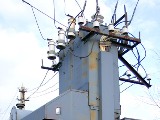Voltage regulation in substations in rural distribution networks
 At present, rural consumers are supplied with electricity mainly through radial power grids from regional transformer substations fed by high-power power systems. In this case, the lines with high as well as with low voltage, as a rule, turn out to be elongated and branched.
At present, rural consumers are supplied with electricity mainly through radial power grids from regional transformer substations fed by high-power power systems. In this case, the lines with high as well as with low voltage, as a rule, turn out to be elongated and branched.
In order to guarantee the quality of the voltage, the value of which for rural electrical installations should not differ from the nominal value by more than ± 7.5%, it is recommended to take measures to improve the voltage. As the main tool used, regulation of the counter voltage in the district distribution substation in combination with the selection of appropriate branches in the substation of the consumers.
Regulation of the counter voltage is understood as a forced increase of the voltage in the networks during the period of the highest loads and its reduction during the period of the lowest loads.In cases where with the help of countercurrent regulation in regional substations and selection of transformer branches of consumer substations, it is still not possible to obtain acceptable voltage levels, use group or local voltage regulation in other ways.
Step-up transformers or longitudinal capacitive compensating devices are used as means of group voltage regulation. As a means of local regulation, transformers with a change in the transformation ratio under load (with a load switch) are used. For this, the wires of the turns of the primary winding of the transformer are switched under load without breaking the circuit.
Currently, the most common transformers are 10 / 0.4 kV with manual switching of the branch terminals when the load is removed and the voltage is switched off (with a voltage off switch). At the same time, branches of the high voltage winding of the transformers are provided, providing the following adjustment steps: -5; -2.5; 0; + 2.5 and + 5%.
No-load operation of step-down transformers with a nominal control step (0%) corresponds to a constant secondary side voltage boost equal to +5%. In general, the following voltage spikes will be respectively at each of the five control steps : 0; +2.5; +5; +7.5; + 10%.
As step-up transformers, as a rule, conventional step-down transformers are used, but the reverse is included, that is, the secondary winding of the step-up transformer becomes the primary, and the switching taps are on the secondary side of the step-up transformer.As a result, for the step-up transformer, a nominal step of 0% corresponds to an allowance of -5%. the remaining voltage steps are given opposite signs. In total, at each of the five stages of regulation, there will be respectively the following voltage spikes: 0; -2.5; -5; -7.5 and 10%.
The selection of the appropriate branches of the transformers is carried out both in the design process and during the operation of rural electrical networks. The required branch, and hence the corresponding allowance, is selected based on the voltage level of the high-voltage substation busbars in the mode of minimum and maximum loads.
In the design of rural distribution networks, when it is difficult to establish the actual load curves, two conditional design modes are set for the selection of branches: the maximum — 100% of the load and the minimum — 25% of the load. For each of the modes, the voltage levels of the transformer busbars are found and the corresponding allowance (adjustment step) is selected, which satisfies the condition for permissible voltage deviations (+ 7.5 ... -7.5%).
During work transformer substations taps of transformers should be selected, taking into account that the voltage level at consumers should not differ from the nominal value by more than ± 7.5%.
Voltage deviations from the nominal value for consumers are determined by the formula
ΔUn = ((Uwaste — Unom) / Unom) x 100
